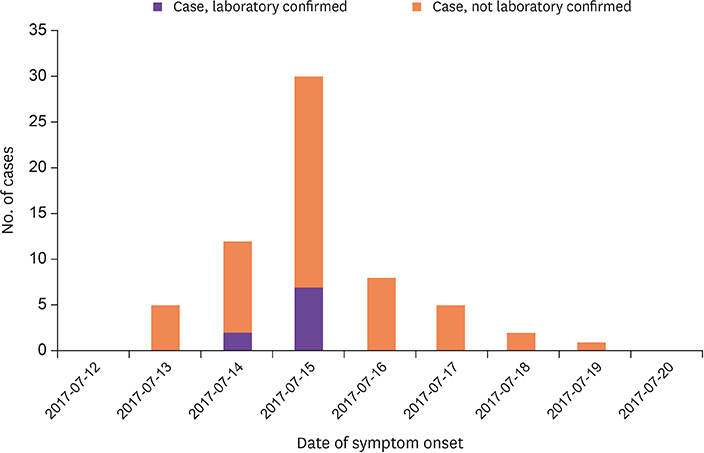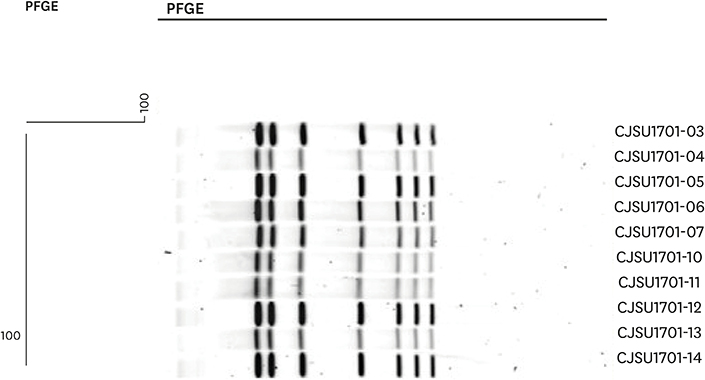Infect Chemother.
2019 Mar;51(1):21-27. 10.3947/ic.2019.51.1.21.
Campylobacter jejuni Foodborne Infection Associated with Cross-contamination: Outbreak in Seoul in 2017
- Affiliations
-
- 1Environmental Health Division, Seoul Metropolitan Government, Seoul, Korea.
- 2Division of Infectious Diseases, Seoul Metropolitan Government-Seoul National University Boramae Medical Center, Seoul, Korea. roundbirch@gmail.com
- 3Department of Epidemiology, Seoul National University Graduate School of Public Health, Seoul, Korea.
- KMID: 2442218
- DOI: http://doi.org/10.3947/ic.2019.51.1.21
Abstract
- BACKGROUND
In July 2017, there was an outbreak of Campylobacter jejuni infection in three auxiliary police squads in Seoul, Korea. An epidemiological investigation was conducted to identify the cause and source of the illness.
MATERIALS AND METHODS
A retrospective cohort study of all members of the three auxiliary police squads was conducted. Self-administered questionnaires were distributed to all members of the three squads and the food handlers. Rectal swabs were collected from symptomatic police and food handlers.
RESULTS
The overall attack rate was 20.4%, and the epidemic curve indicated a point source type outbreak. Of the 257 auxiliary policemen who consumed the incriminated lunch, 55 met the case definition. Of 36 rectal swabs, 10 were positive for C. jejuni and had the same pulsed-field gel electrophoresis pattern. The major symptoms were loose stool (100%) and abdominal pain (59.3%); the median incubation period was 69 hours. In the univariate epidemiological analysis, watermelon (relative risk [RR], 5.75; 95% confidence interval [CI], 2.14-15.43), half-cut chicken soup (RR, 3.96; 95% CI, 1.49-10.54), steamed rice with millet (RR, 2.73; 95% CI, 1.29-5.77), and radish kimchi (RR, 2.57; 95% CI, 1.45-4.55) were positively associated with the illness. Inspection of the food service facility found that the drainpipe under the meat cleaning sink did not work.
CONCLUSION
This outbreak could have been caused by cross-contamination with C. jejuni from raw chicken via environmental sources.
Keyword
MeSH Terms
Figure
Reference
-
1. Gillespie IA, O'Brien SJ, Adak GK, Tam CC, Frost JA, Bolton FJ, Tompkins DS. Campylobacter Sentinel Surveillance Scheme Collaborators. Point source outbreaks of Campylobacter jejuni infection-are they more common than we think and what might cause them? Epidemiol Infect. 2003; 130:367–375.2. Ruiz-Palacios GM. The health burden of Campylobacter infection and the impact of antimicrobial resistance: playing chicken. Clin Infect Dis. 2007; 44:701–703.
Article3. Jung SM, Kim NO, Na HY, Hong SH, Chung GT. Prevalence of Campylobacter causing acute diarrhea in Korea, 2012-2015. Public Health Wkly Rep. 2016; 9:526–530.4. Silva J, Leite D, Fernandes M, Mena C, Gibbs PA, Teixeira P. Campylobacter spp. as a foodborne pathogen: a review. Front Microbiol. 2011; 2:1–12.5. Farmer S, Keenan A, Vivancos R. Food-borne Campylobacter outbreak in Liverpool associated with cross-contamination from chicken liver parfait: implications for investigation of similar outbreaks. Public Health. 2012; 126:657–659.
Article6. Yu JH, Kim NY, Cho NG, Kim JH, Kang YA, Lee HG. Epidemiology of Campylobacter jejuni outbreak in a middle school in Incheon, Korea. J Korean Med Sci. 2010; 25:1595–1600.
Article7. Centers for Diseases Control and Prevention. Epi Info™. Accessed 15 August, 2017. Available at: https://www.cdc.gov/epiinfo.8. Kaakoush NO, Miller WG, De Reuse H, Mendz GL. Oxygen requirement and tolerance of Campylobacter jejuni. Res Microbiol. 2007; 158:644–650.9. Oh E, McMullen L, Jeon B. High prevalence of hyper-aerotolerant Campylobacter jejuni in retail poultry with potential implication in human infection. Front Microbiol. 2015; 6:1263.
Article10. Friedman CR, Neimann J, Wegener HC, Tauxe RV. Epidemiology of Campylobacter jejuni infections in the United States and other industrialized nations. In : Nachamkin I, Blaser MJ, editors. Campylobacter. 2nd ed. Washington DC: ASM International;2000. p. 121–138.11. Medeiros DT, Sattar SA, Farber JM, Carrillo CD. Occurrence of Campylobacter spp. in raw and ready-to-eat foods and in a Canadian food service operation. J Food Prot. 2008; 71:2087–2093.
Article12. Kennedy J, Nolan A, Gibney S, O'Brien S, McMahon M, McKenzie K, Healy B, McDowell D, Fanning S, Wall P. Determinants of cross-contamination during home food preparation. Brit Food J. 2011; 113:280–297.13. Olsen SJ, Hansen GR, Bartlett L, Fitzgerald C, Sonder A, Manjrekar R, Riggs T, Kim J, Flahart R, Pezzino G, Swerdlow DL. An outbreak of Campylobacter jejuni infections associated with food handler contamination: the use of pulsed-field gel electrophoresis. J Infect Dis. 2001; 183:164–167.
Article14. Fitzgerald C. Campylobacter. Clin Lab Med. 2015; 35:289–298.
Article
- Full Text Links
- Actions
-
Cited
- CITED
-
- Close
- Share
- Similar articles
-
- Epidemiology of Campylobacter jejuni Outbreak in a Middle School in Incheon, Korea
- A Case of Campylobacter jejuni Enterocolitis with Acute Pancreatitis and Hemolytic Uremic Syndrome
- Antimicrobial Susceptibility and Genetic Analysis of Campylobacter jejuni Isolated from Diarrhea Patients in Busan
- Campylobacter jejuni Bacteremia in a Healthy Child
- Campylobacter jejuni Bacteremia in a Liver Cirrhosis Patient and Review of Literature: A Case Study



